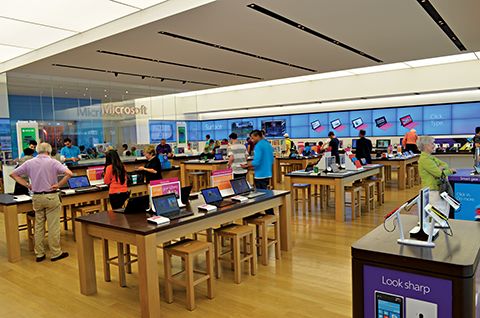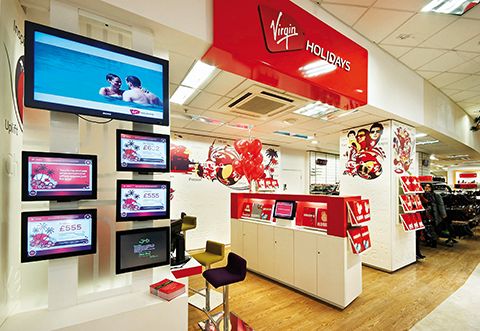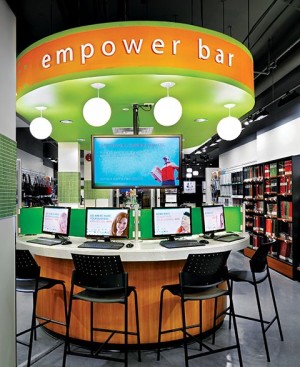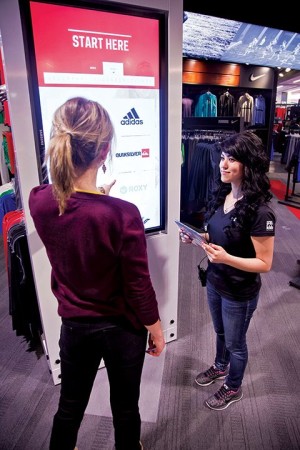Digital Signage: Dynamic media in retail
by all | 25 March 2015 9:21 am
 [1]
[1]Photo courtesy Microsoft Stores
By Lyle Bunn
Challenges facing the retail sector have never been greater. Bricks-and-mortar stores compete not just with each other, but also with online commerce. A store is still the ideal facility for meeting shoppers’ needs, so long as retailers can respond to the shifting landscape, including rapidly changing consumer attitudes and behaviours.
Place-based digital signage, in many cases, is providing a significant return on investment (ROI) and serving as a platform for introducing other technology-related marketing approaches, such as electronic shelf labels, wireless-fidelity (Wi-Fi) hot spots, near field communication (NFC) and location-aware mobile marketing. It can even showcase products that may not be available within the store but can be requested from an alternate location or even ordered online while the customer is in the store. As such, digital signage has become a key tool in addressing today’s retail challenges.
Personalizing the experience
With a recent survey of retailers by KPMG reporting the top two drivers of growth in the next three years will be retaining customers (37 per cent) and adding customers (35 per cent), it is important to keep in mind shopping is personal. People will shop regularly at locations that fulfil their needs and wants at fair prices, reflect their lifestyle and interests, provide an appealing environment, offer a variety of buying options and ensure satisfaction through helpful staff, inventory access, return policies and other customer-friendly policies.
Point-of-Purchase Advertising International (POPAI), meanwhile, reports 70 per cent of purchasing decisions are made in-store. This reinforces the importance of both (a) making the store an attractive destination to ensure traffic and (b) using in-store digital signage and other promotional media to turn browsers into buyers.
“Transitioning retail space from a ‘supply chain’ utility, where dwell time is minimal, to a place where experiences happen is a critical success factor,” said Audrey Hendley, senior vice-president and general manager (GM) of prospect engagement and new member acquisition for American Express, when addressing delegates at the Customer Engagement World (CEW) show in November 2014.
 [2]
[2]Digital signage complements printed graphics in retail environments by showcasing dynamic content. Photo courtesy Tripleplay Services
Indeed, the overall goal of ‘customer engagement’ is one reason retail is among the top vertical markets for digital signage.
Visual appeal
While retail environments are full of products, packaging, labels and fixtures, virtually all of these elements are ‘static,’ lacking motion to attract the eye and entice shoppers. Motion gets noticed and customers—even unconsciously—will respond to it by reassessing what interests them. Messages are received and filtered based on relevance and appeal.
“Consumer actions are impacted by digital signage,” says Chris Riegel, founder and CEO of Stratacache. “High-quality graphics of premium products, showing their features and benefits, entice consumers to select them versus other products.”
Revenue increases can be achieved through several ways. Enhancing the visual appeal of the store can improve traffic, but then the next job is to convert browsers to buyers. Digital signage can increase their dwell time, making them more likely to purchase a larger basket of goods. And as mentioned, content can be specifically geared to cross-sell or upsell.
Compared to other media, content need not be ‘shrill’ to capture attention. Active content can be presented calmly and confidently at a prime location, outlining the store’s points of value and a call to action.
For that matter, place-based content can ‘play nice’ with other media. Content developed for TV, printed collateral, static signs or other formats can be repurposed for digital signage, with the opportunity to augment it by shortening, regionalizing and/or animating it, at minimal additional cost. Moreover, content can be updated rapidly, so there is more of a chance to test-market and refine messages with digital signage before extending them to traditional media.
 [3]
[3]Large-scale screens can help draw attention to focal areas within a store. Photo courtesy Shikatani Lacroix Brandesign
Paid or owned?
Digital signage can fit into retailers’ overall communications strategies as either ‘paid’
or ‘owned’ media.
In a ‘paid’ version, networks deliver digital out-of-home (DOOH) advertising to target consumers. Within a retail environment, this advertising would be for third parties, particularly vendors whose products are available at the store. Research by PQ Media suggests DOOH advertising is growing by 16 per cent annually.
Digital signage ‘owned’ by retailers, on the other hand, is used for branding, merchandising, upselling and other in-house purposes. PQ reports the overall digital signage industry, including owned media, is experiencing a compound annual growth rate (CAGR) of 23 per cent.
While the benefits of paid media are clear in terms of earned revenue, owned media is also favoured by retailers for supporting their business in a variety of ways. They can tailor digital signage content not only to educate shoppers about new products and services, but also to reinforce their brands, announce in-store campaigns and offers and empower customer service staff. And as multipurpose systems, digital signs can help minimize the costs of in-store promotions.
In terms of empowering staff, beyond educating customers about products, digital signage networks can be extended into employee rest areas, where screens can display more corporate messaging, including training information.
Tools for the job
A typical retail digital signage network comprises flat-panel liquid crystal displays (LCDs) positioned at decision points and high-traffic areas, connected to media players. Content management system (CMS) software is used to control message playback and to monitor the screens.
LCDs may be mounted on walls, pillars or fixtures or hung from the ceiling, either as single screens or combined to form a video wall. Content ‘spots’ are typically integrated into playlists lasting anywhere from two to 20 minutes, often to coincide with a shopper’s average time within viewing distance.
Display hardware and media players for retail digital signage need to be able to withstand long duty cycles. Operating in a retail environment can also be very demanding in terms of heat, humidity and airborne particles. A typical consumer TV is not warranted for such circumstances; it is important to use professional-grade products.
As mentioned, digital signage can serve as a platform for other technologies. Shoppers may be directed to ‘opt in’ or ‘download’ with their smartphones, scan a Quick Response (QR) code or use NFC to receive a special offer. Such options offer one-on-one engagement, tapping into the personal nature of shopping.
 [4]
[4]Interactive screens provide an opportunity for customers and employees to source further information about products. Photo courtesy SportCheck
There are hundreds of CMS software options today, each offering different approaches and benefits. The most minimal systems publish images the same way Microsoft PowerPoint does for presentations, while others offer much more advanced multimedia capabilities. Usually, a CMS playout module residing on the media player is paired with a central CMS, enabling central control of not just content, but also operational functions, including brightness, audio levels and even turning screens on and off.
In this way, CMS software can monitor digital signage network performance. Further data can also be gathered through analytics. In-store Wi-fi service with ‘pre-opt-in’ functionality, for example, can measure store customers’ traffic patterns and dwell times via
their smartphones.
“Insights such as traffic patterns, sales floor product placement effects, dwell times and browsing outcomes are invaluable to assure retail success,” says Carl Ceresoli, senior director of infrastructure, architecture and strategy for Microsoft Stores.
Reliable connectivity is very important, whether delivered by cable, cellular signal, in-house intranet or satellite. Media players typically store predefined playlists and associated media to ensure continual playback in case of interruptions elsewhere in the communications infrastructure.
Making it happen
In-store digital signage has certainly matured significantly since the days of videotape loops playing on small cathode ray tube (CRT) TVs. In the past 10 years, especially, there has been substantial growth in functionality and reduction of costs for displays, media players and connectivity.
That said, in-store digital signage that stands alone is soon orphaned. The medium needs to be integrated with other types of signage and promotional media for it to thrive.
Lyle Bunn is a digital signage consultant based in Brighton, Ont. This article is adapted from a report he published in January. For more information, contact him via e-mail at lyle@lylebunn.com.
- [Image]: http://www.signmedia.ca/wp-content/uploads/2015/03/TorontoMicrosoftStore8.jpg
- [Image]: http://www.signmedia.ca/wp-content/uploads/2015/03/tripleplay.jpg
- [Image]: http://www.signmedia.ca/wp-content/uploads/2015/03/GT-061.jpg
- [Image]: http://www.signmedia.ca/wp-content/uploads/2015/03/interactive.jpg
Source URL: https://www.signmedia.ca/digital-signage-dynamic-media-in-retail/